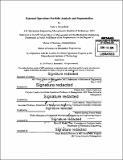External operations portfolio analysis and segmentation
Author(s)
Rosenfield, Todd A
DownloadFull printable version (3.898Mb)
Other Contributors
Leaders for Global Operations Program.
Advisor
Charles Fine and Josef Oehmen.
Terms of use
Metadata
Show full item recordAbstract
This thesis focuses on a medical device manufacturer, Company X, using a razor-and-blades business strategy, in which surgical instruments are offered to customers at little or no cost in order to facilitate the sale of certain implantable products that require the use of such instruments. It faces considerable challenges in managing the instrument supply chain. Company X is interested in better understanding its instrument portfolio through segmentation so that it can efficiently manage its supply chain with an appropriate supply chain strategy for each segment. This thesis deals with the development of a segmentation methodology that can be used to objectively rank and segment medical device products that do not directly generate sales revenues, but contribute to the revenues generated by a dependent class of products. A methodology was developed to rank and segment the instruments within Company X's instrument portfolio using criticality heuristics. The segments were then evaluated for opportunities for inventory reduction without harming service levels. In addition, a cost minimization decision tool was developed to determine the optimal amount of excess inventory that should be discarded when items subject to minimum order quantities. Using the segmentation methodology and the minimum order quantity decision tool, Company X can potentially reduce its inventory value by over 60%.
Description
Thesis: M.B.A., Massachusetts Institute of Technology, Sloan School of Management, 2014. In conjunction with the Leaders for Global Operations Program at MIT. Thesis: S.M., Massachusetts Institute of Technology, Department of Mechanical Engineering, 2014. In conjunction with the Leaders for Global Operations Program at MIT. Cataloged from PDF version of thesis. Includes bibliographical references (pages 61-62).
Date issued
2014Department
Leaders for Global Operations Program at MIT; Massachusetts Institute of Technology. Department of Mechanical Engineering; Sloan School of ManagementPublisher
Massachusetts Institute of Technology
Keywords
Sloan School of Management., Mechanical Engineering., Leaders for Global Operations Program.